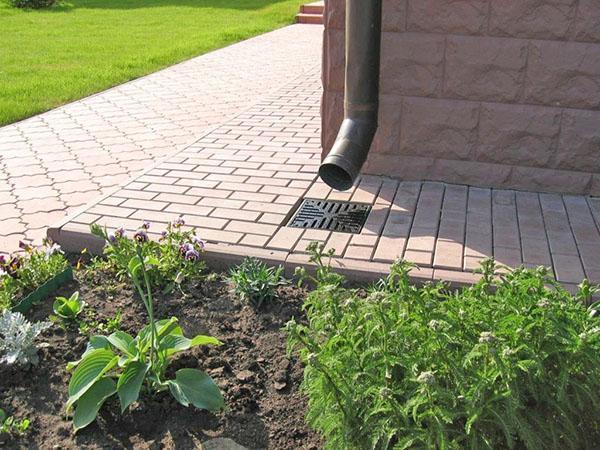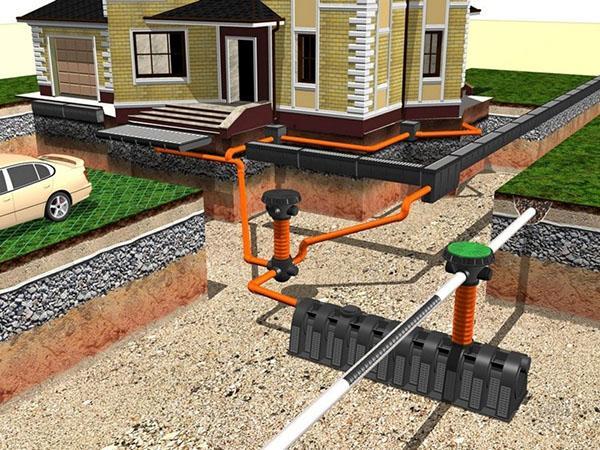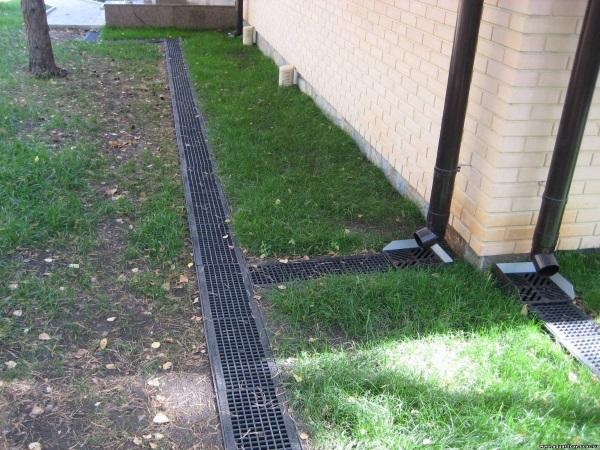Do-it-yourself high-quality storm sewer in a private house
 Water accumulating in the rain or from melting snow near the house can lead to flooding and destruction of the foundation. To prevent this from happening, a storm sewer is required in a private house.
Water accumulating in the rain or from melting snow near the house can lead to flooding and destruction of the foundation. To prevent this from happening, a storm sewer is required in a private house.
In addition, it is required for the accumulation of water resources in regions with arid climates. And also to drain excess moisture from vegetation in the local area. You can easily assemble it yourself.
Storm sewer in a private house: device

Trays or storm water inlets for storm sewers, according to drainage methods, are divided into:
- closed type;
- open;
- combined type.
An open and closed storm sewer in a private house is considered part of the path. In the first case (simple point sewerage) from the roof through the drain pipe, water enters the tray. In the second (closed) version, water enters a buried pipe, then into a collector to collect water. Closed trays are directly mounted in them, leaving only gratings on the surface. Through them, moisture goes into the underground pipeline. This type is used for large building perimeters.
 For an open storm sewer in a private house, external water intakes are used. They are open and surface mounted.
For an open storm sewer in a private house, external water intakes are used. They are open and surface mounted.
 By design, they do not differ from closed ones, but they are flooded more often, so more care is needed. Apply such drainage for summer cottages or a small cottage. There is a third type of storm drainage system - mixed or combined. The features of internal and external drainage are combined here. In it, one part of the stormwater is carried out with closed drains, the other with open ones.
By design, they do not differ from closed ones, but they are flooded more often, so more care is needed. Apply such drainage for summer cottages or a small cottage. There is a third type of storm drainage system - mixed or combined. The features of internal and external drainage are combined here. In it, one part of the stormwater is carried out with closed drains, the other with open ones.
Drainage elements

Drains and drainage lines come from:
- plastic;
- concrete;
- cast iron;
- alloy steel;
- aluminum.
For the arrangement of storm sewers in a private house with their own hands, plastic and steel materials are used, since they are reliable in operation and easy to install.
The storm sewer system consists of:
- gutters and storm water inlets;
- filters;
- pipe networks;
- collectors for collecting water.
Gutters and storm water inlets
 This is the initial link in the system through which wastewater enters the drain and pipeline. When choosing a material, preference should be given to concrete or plastic, since metal ones are very noisy under the blows of rain and gusts of wind, if they are not buried in the ground. Moreover, they are susceptible to corrosion. Concrete is more reliable and has a long service life. However, such gutters have strictly regulated dimensions and it is not always possible to install them on the site. Plastic is easily cut and combined, and the stormwater inlet can have different depths of the well. With an already existing blind area, they can be easily mounted without dismantling it.
This is the initial link in the system through which wastewater enters the drain and pipeline. When choosing a material, preference should be given to concrete or plastic, since metal ones are very noisy under the blows of rain and gusts of wind, if they are not buried in the ground. Moreover, they are susceptible to corrosion. Concrete is more reliable and has a long service life. However, such gutters have strictly regulated dimensions and it is not always possible to install them on the site. Plastic is easily cut and combined, and the stormwater inlet can have different depths of the well. With an already existing blind area, they can be easily mounted without dismantling it.
Filters
 Designed to trap stones, leaves, sand, branches and other debris that can clog pipes. Lattices allow less frequent cleaning of storm sewers, eliminate the risk of stumbling. Cast iron is reliable as a material for making a grate, but it requires painting every 2 years. Steel rusts quickly.
Designed to trap stones, leaves, sand, branches and other debris that can clog pipes. Lattices allow less frequent cleaning of storm sewers, eliminate the risk of stumbling. Cast iron is reliable as a material for making a grate, but it requires painting every 2 years. Steel rusts quickly. Aluminum can be considered the best option because it has a long service life and looks stylish. However, it is somewhat more expensive.
Aluminum can be considered the best option because it has a long service life and looks stylish. However, it is somewhat more expensive.
The dimensions of the holes should not be very small, since they should let a lot of water pass at once, but not large, otherwise debris will penetrate into the system and lead to its clogging.
Pipe networks
 The pipes transfer the flow to the water collection point. If they are made of PVC, then this is an ideal solution for storm sewers. Their smooth surface eliminates the risk of silting. Their diameter is 100-150 mm.
The pipes transfer the flow to the water collection point. If they are made of PVC, then this is an ideal solution for storm sewers. Their smooth surface eliminates the risk of silting. Their diameter is 100-150 mm.
Collector for collecting water
 The collector is part of a closed and mixed stormwater system and is a reservoir for receiving the main stream of water. A similar well can be equipped with a sand and gravel cushion and concrete rings or a concrete ring with a bottom to use the liquid in the future. A plastic well is collected from PVC molds. It is perfect for those areas where groundwater is superficial. Water disposal takes place using a pipeline system, and moisture can also be used for economic purposes on the site.
The collector is part of a closed and mixed stormwater system and is a reservoir for receiving the main stream of water. A similar well can be equipped with a sand and gravel cushion and concrete rings or a concrete ring with a bottom to use the liquid in the future. A plastic well is collected from PVC molds. It is perfect for those areas where groundwater is superficial. Water disposal takes place using a pipeline system, and moisture can also be used for economic purposes on the site.
Instead of a collector, it is permissible to make drainage from a special perforated plastic container with water discharge into the ground, placing it horizontally and burying it in the sand. Through the holes, moisture will gradually seep into the sand and go into the depths.
 In addition, the stormwater device can be supplemented with a bottom tray installed near the porch at the front door, pipes for soil drainage, and a hatch for access to the system.
In addition, the stormwater device can be supplemented with a bottom tray installed near the porch at the front door, pipes for soil drainage, and a hatch for access to the system.
Operating principle
The main principle of the sewage system is to adhere to gravity, for which it is necessary to take into account the following factors:
- The location of the building to determine the length of the stormwater pipes around the house.
- Relief features of the area.
- Climate and rainfall in order to determine the volume and number of wells and pipes.
With an average annual rainfall of 60-90 cubic meters. m, the pipe diameter should be 11-12 cm.
 The installation scheme for storm trays in the courtyard of the house depends on the type of rainfall collection. It can be linear or point.
The installation scheme for storm trays in the courtyard of the house depends on the type of rainfall collection. It can be linear or point.
The layout of the system should be considered when designing the house so that the drains are discharged in a straight line and there are fewer problems with cleaning.
The diagram indicates the location of communications, storage, equipment and drain circuits. When combining drainage and stormwater into the sewer, a more serious approach and a geodetic survey of the territory will be required in order to identify the level of groundwater. This will make it possible to determine the most convenient place for the accumulator and drainage pads.
Installation
Before installation, the territory is marked in order to determine the location of the trenches. If turns are necessary, then they must be done at right angles and inspection hatches should be made in these places.
Installation of ground channels, trays and gutters should be carried out in open areas of the site. When installing the tray, the soil around it should be compacted to prevent soil subsidence.
Pipes are laid with a slope of 1 cm per 1 m of length.
It is better to use them from PVC, since the material does not corrode. Pipes are laid in a trench, into which crushed stone and sand are first poured, geotextiles are spread.
Then the pipe is completely wrapped with geomaterial and the trench is covered with excavated soil.
The connections are made with couplings that are suitable in size and type.
Finally, the receiver is installed.
Installation is carried out with a bias towards the drive.
If the elements of the system pass under the functional areas (entrance, track, parking lot), then additional reinforcement in the form of an overlap with further backfilling with soil will be required.
Cleaning function
 The storm drainage system, unlike a septic tank, does not need deep cleaning. In this case, water can be discharged into the ground, the nearest stream, ravine, or used for irrigation.
The storm drainage system, unlike a septic tank, does not need deep cleaning. In this case, water can be discharged into the ground, the nearest stream, ravine, or used for irrigation.
At the same time, without violating sanitary and hygienic standards and soil ecology. But basic filtration is necessary, for which sand traps are used to trap various debris, stones, leaves, and more. Also, the pipes are periodically flushed with a jet pressure using a pump. The stream can eliminate contamination in hard-to-reach places. The drive is cleaned separately using disinfectants.
The construction market offers all kinds of storm sewer options, so any configuration can be applied. The most reliable is the trench system using trays, wells, a collector, filter membranes. But it is provided for a large area; for a small area, an open storm drain around the perimeter of the house is suitable. The drainage can be connected to a septic tank with multi-stage biological wastewater treatment.
Only rain and melt water does not need fine filtration. For them, it is enough to equip the system with gratings and filters, but they must be cleaned mechanically, otherwise the canals can become clogged, causing a flood of the territory.